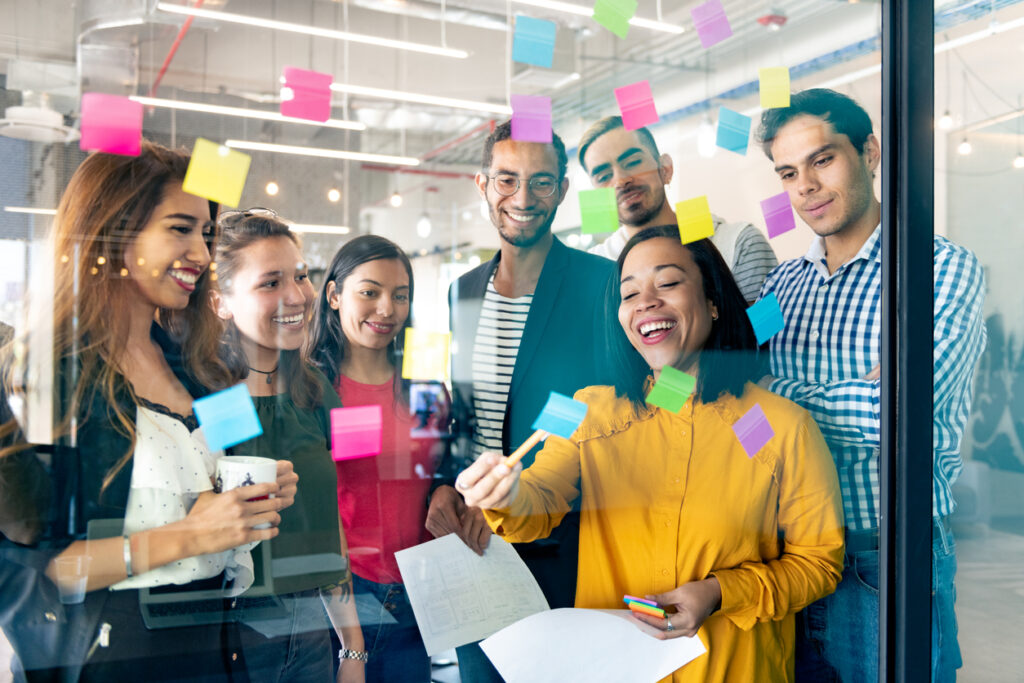What is innovation? What springs immediately to mind is technology, especially when it comes to learning. The digital era requires us all to be lifelong learners. It also stresses the importance of creative problem solving and the ability to make connections in order to drive innovation.
There’s no innovation without experimentation, and experimentation sometimes comes with failure.
In the digital age, we must not only be able to find and navigate information, but also be able to critically interpret that information. Any learning innovation must create more effective learning. Here are several examples of how this can happen.
Empathy
As we move towards an era more dominated by artificial intelligence, empathy will become the differentiator between human beings and machines. That means learners will be engaging in activities and exercises aimed at stimulating empathy. Design thinking is an empathetic and innovative technique of problem solving that means putting yourself into the shoes of the people experiencing the problem or issue. That means taking time to ask questions, to ask more questions and to seek to understand what drives behaviour.
In an era of innovation, we need to innovate and disrupt, but there’s no innovation without experimentation, and experimentation sometimes comes with failure. The good thing about design thinking is that failure becomes a learning opportunity.
Trainer and teacher support
A commitment to learning innovation can take many forms. It may be investing in a centre for teaching and learning (CTL) to provide staff with training, mentoring, and resources. Alternatively, a commitment to learning innovation may manifest in the recruitment of instructional designers to collaborate with trainers to create stronger online offers.
It could even involve the decision that all new training spaces and renovations will result in active learning spaces, with flat floors and moveable furniture. So many training rooms I work in have fixed large tables and environments more suited to passive learning rather than a flipped active learning approach.
Blended learning
We know that online learning by itself is not enough to embed new behaviours and practices. Leaving learners to learn independently via mobile devices is a waste of investment. This is because learning happens continuously, in a multiplicity of contexts and modes, supported by technologies that enable any learner to easily access internal and external information and interact with networks of experts and peers both on and off-line. Mixing formats makes learning more effective. Choosing the right format for the right purpose is critical.
Experiential learning
Lots of people talk about experiential learning, but what is it? Isn’t all learning an experience? In simple terms, it means learning by doing and experiencing real behaviours in real time and then thinking about the experience and having a sense of how to apply that learning. So it’s about assimilating knowledge by trying something out. It’s a very hands-on way of developing knowledge and awareness. It builds confidence, a real understanding and insight of strengths and strategies for working on weaknesses.
There are some key things that must happen for this to be successful. Learners have to feel good about what they’re doing, feel in control of the process and feel connected to the outcomes. The facilitator has to be very skilled at leading the session and at enabling learners to reflect effectively. Experiential learning requires a very high degree of expertise from the facilitator in terms of the reflection process and learner impact relies heavily on this.
The trouble is that most training does not include sufficient reflection time. The focus is often very much on the activity with some review, but for real learning transfer to take place learners need to be able to not only interpret their behaviour and role in the exercise but they also need to think about it and have support in linking it to day-to-day experiences so that next time when they are in a situation where they need to apply a collaborative skill or a degree of adaptability they have something to draw on rather than resorting to default behaviour. This means having a much stronger focus on reflection.
Interested in this topic? Read Learning innovation and strategic intent: moving L&D to the next level.
What is innovation? What springs immediately to mind is technology, especially when it comes to learning. The digital era requires us all to be lifelong learners. It also stresses the importance of creative problem solving and the ability to make connections in order to drive innovation.
There’s no innovation without experimentation, and experimentation sometimes comes with failure.
In the digital age, we must not only be able to find and navigate information, but also be able to critically interpret that information. Any learning innovation must create more effective learning. Here are several examples of how this can happen.
Empathy
As we move towards an era more dominated by artificial intelligence, empathy will become the differentiator between human beings and machines. That means learners will be engaging in activities and exercises aimed at stimulating empathy. Design thinking is an empathetic and innovative technique of problem solving that means putting yourself into the shoes of the people experiencing the problem or issue. That means taking time to ask questions, to ask more questions and to seek to understand what drives behaviour.
In an era of innovation, we need to innovate and disrupt, but there’s no innovation without experimentation, and experimentation sometimes comes with failure. The good thing about design thinking is that failure becomes a learning opportunity.
Trainer and teacher support
A commitment to learning innovation can take many forms. It may be investing in a centre for teaching and learning (CTL) to provide staff with training, mentoring, and resources. Alternatively, a commitment to learning innovation may manifest in the recruitment of instructional designers to collaborate with trainers to create stronger online offers.
It could even involve the decision that all new training spaces and renovations will result in active learning spaces, with flat floors and moveable furniture. So many training rooms I work in have fixed large tables and environments more suited to passive learning rather than a flipped active learning approach.
Blended learning
We know that online learning by itself is not enough to embed new behaviours and practices. Leaving learners to learn independently via mobile devices is a waste of investment. This is because learning happens continuously, in a multiplicity of contexts and modes, supported by technologies that enable any learner to easily access internal and external information and interact with networks of experts and peers both on and off-line. Mixing formats makes learning more effective. Choosing the right format for the right purpose is critical.
Experiential learning
Lots of people talk about experiential learning, but what is it? Isn’t all learning an experience? In simple terms, it means learning by doing and experiencing real behaviours in real time and then thinking about the experience and having a sense of how to apply that learning. So it’s about assimilating knowledge by trying something out. It’s a very hands-on way of developing knowledge and awareness. It builds confidence, a real understanding and insight of strengths and strategies for working on weaknesses.
There are some key things that must happen for this to be successful. Learners have to feel good about what they’re doing, feel in control of the process and feel connected to the outcomes. The facilitator has to be very skilled at leading the session and at enabling learners to reflect effectively. Experiential learning requires a very high degree of expertise from the facilitator in terms of the reflection process and learner impact relies heavily on this.
The trouble is that most training does not include sufficient reflection time. The focus is often very much on the activity with some review, but for real learning transfer to take place learners need to be able to not only interpret their behaviour and role in the exercise but they also need to think about it and have support in linking it to day-to-day experiences so that next time when they are in a situation where they need to apply a collaborative skill or a degree of adaptability they have something to draw on rather than resorting to default behaviour. This means having a much stronger focus on reflection.
Interested in this topic? Read Learning innovation and strategic intent: moving L&D to the next level.





